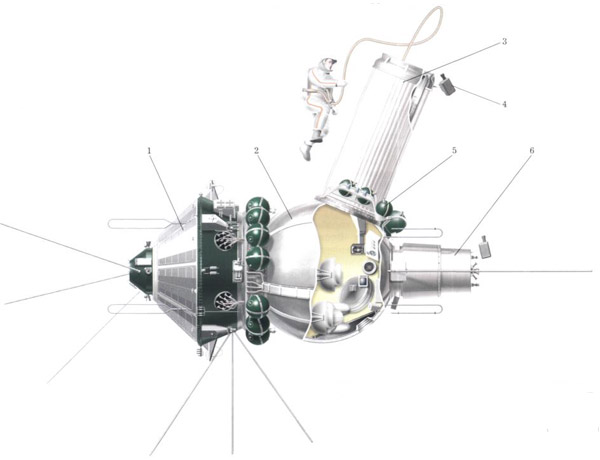Voskhod Space Program.
The Voskhod program (Russian for “Sunrise”) was developed for spaceflights in the multi-seated Voskhod spacecraft to carry out technical, scientific and medical experiments. The program was executed during the period of 1963-1966. The program terminated incomplete.
The Voskhod spacecraft was the first multi-seated manned spaceship in the world. It was created at OKB-1 under the direction of Korolev S.P. in 1963-1964, derived from the spaceship Vostok. The Voskhod had three versions: three-seater, two-seater with an airlock for a space walk, and a two-seater version for a long-duration flight. As distinguished from the Vostok the Voskhod spacecraft was equipped with a soft landing system, and so cosmonauts could land inside the descent module.
The first model of the spaceship - 3KV- developed for space flights with a crew of three cosmonauts without wearing space suits. Two spacecrafts of this modification were launched: unmanned Cosmos-47 and manned Voskhod.
The second model - 3KD - had Berkut spacesuits with life-support system for two cosmonauts and an airlock chamber. Two spacecrafts of this kind were launched: unmanned Cosmos-47 and manned Voskhod-2
The third model (also designated as 3KV) - developed for long duration flights (up to 20 days) for a crew of two cosmonauts without spacesuits on. This type of the Voskhod spacecraft was launched unmanned in 1966 under the name of Cosmos-110 with animals onboard. This model never launched with people onboard.

7 manned Voskhod spaceships in total had been planned to launch. The Voskhod-3 spaceship had to perform a long-term flight with a scientific research program, followed by some military-purpose tasks. Afterwards the Voskhod was supposed to execute a female crew flight with a spacewalk performed by a woman for the first time in the history of space exploration, then a flight of two-seater spaceship with a medical research program, which included a surgery of an experimental animal (a rabbit) under space flight conditions. It was also planned to carry out a space flight to test a translational aid for a cosmonaut in open space, and to perform a space experiment on creation of artificial gravity by spinning the Voskhod spacecraft with the third stage of the booster rocket, connected with a cable. However, in mid-1966 the program Voskhod was closed, the following development and production of the spacecraft were terminated. The manned spaceship Voskhod-3, prepared for launch, never launched.
Due to the fact that Voskhod was a multi-seated spaceship, there was a possibility to send representatives of other professions and occupations apart from the cosmonauts of Air Force into space. Companies and agencies, directly involved in implemention of the program, selected their own candidates for the flights. The following people were selected: engineers from OKB-1, military doctors from the Aeromedical Research Institute and the CTC, civilian physicians from the Institute of Biomedical Problems, and research scientist of the USSR Academy of Sciences.
The main results of the program achieved: first space walk.
The Voskhod spacecraft was put into orbit by the Soyuz launch vehicle. Cosmonauts’ rescue in an emergency event of the launch vehicle on the launch pad or during the initial ascent was not provided. This fact became one of the reasons for this program termination.


